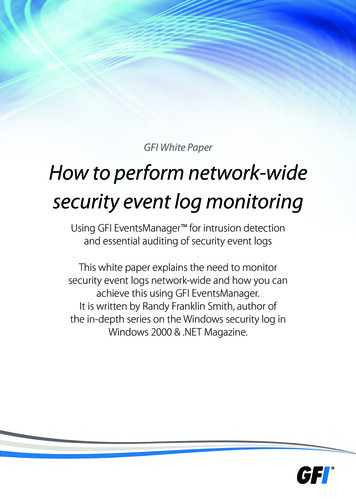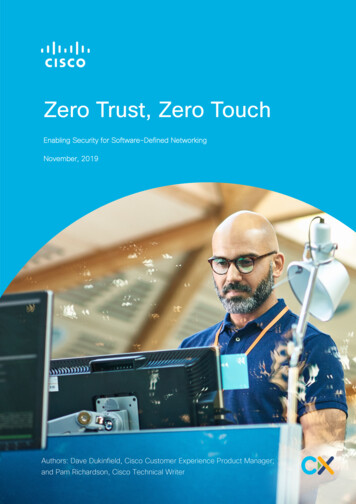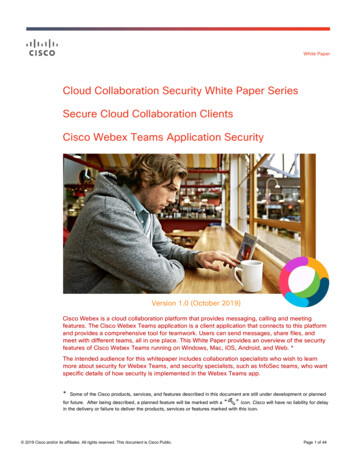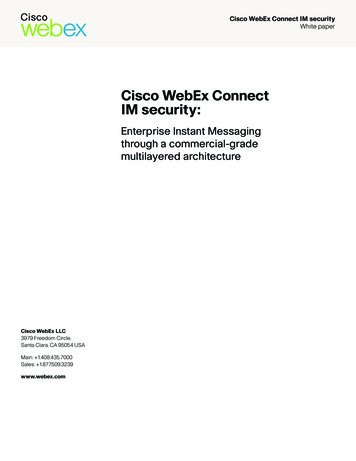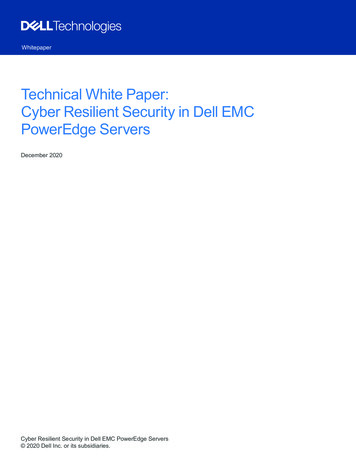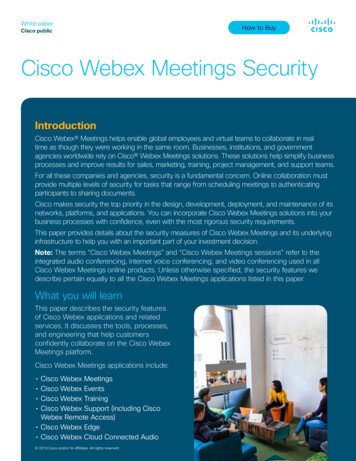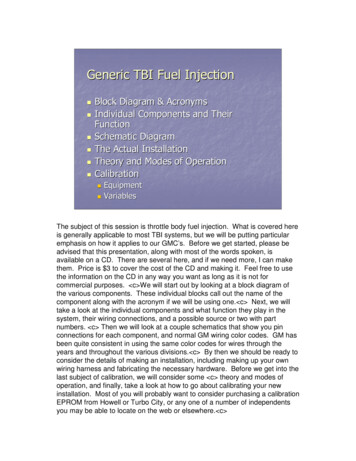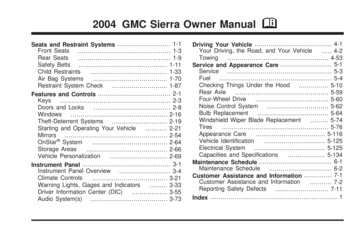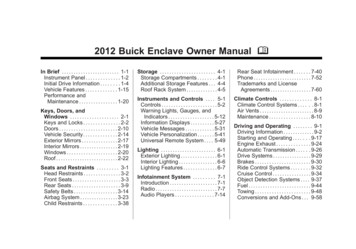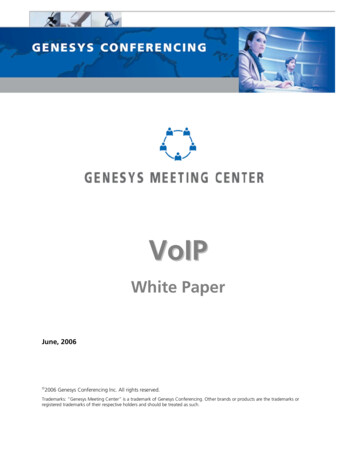
Transcription
VoIPWhite PaperJune, 2006 2006 Genesys Conferencing Inc. All rights reserved.Trademarks: “Genesys Meeting Center” is a trademark of Genesys Conferencing. Other brands or products are the trademarks orregistered trademarks of their respective holders and should be treated as such.
Genesys Meeting Center VoIP White PaperContentsContents. iIntroduction. 1Drivers for VoIP adoption – the “dream” . 1About VoIP . 3Components of a VoIP Network . 3IP PBX . 3IP Network . 3End User Devices . 3Session Initiation Protocol . 4VoIP Gateway . 4Multi-Protocol Label Switching (MPLS) . 4VoIP Advantages and Disadvantages . 6Advantages. 6Cost Savings. 6Convergence. 6Portability . 6Increased Productivity. 6Drawbacks. 6Latency . 6Jitter . 7Packet Loss . 7Other . 7Moving to Genesys and VoIP . 81. Backend Upgrade. 8Better Failover. 8Improved Scalability. 8Continued Product Evolution . 92. Enterprise Connectivity . 93. Genesys VoIP SoftPhone. 9Low Bandwidth. 10High Latency Tolerance . 10Firewall Friendly. 10Minimum System Requirements. 12VoIP Access . 13Genesys IDC . 13Access Methods . 14PSTN. 14VPN. 15Internet (audio). 15Internet (web). 15VoIP Security . 16Contact Us. 17Genesys Worldwide. 17Key Terms - References . 18Genesys Conferencingi
Genesys Meeting Center VoIP White PaperIntroductionGenesys Conferencing is one of the world’s first companies to offer a multimediaconferencing platform, which tightly integrates audio, web, multi-point video andenterprise solutions to provide the richest collaboration experience available in themarketplace today. With its commitment to innovation, Genesys is expanding its serviceofferings to include several variations of Voice over Internet Protocol (VoIP).1VoIP is a technology that transmits voice over data networks. Its main application is toallow individuals to conduct voice conversations over an IP network instead of theexisting public switched telephone network (PSTN2). This document will focus on VoIPsolutions for enterprises.The first VoIP application was presented in 1992, and, although the VoIP adoption ratehas been slower than originally expected, it is now quickly gaining market share. In theshort term, it is unlikely that VoIP will become a replacement for all components oftraditional telephony. However, according to a report by Integrated Research, 78% oflarge companies worldwide are deploying IP telephony, in one form or another.Drivers for VoIP AdoptionThere are two major factors driving the adoption of VoIP within enterprises:Lower Costs VoIP is a disruptive technology, helping to bring down the cost for telephony.Traditional suppliers, both in the telecom and network worlds, are now competingwith a variety of new entrants, as Internet and IP connectivity can now beobtained from new players in the market. Similarly, we have seen new companies launching communications and PSTNsolutions in the infrastructure arena. These new solutions or alternatives areoffered at a fraction of the cost of traditional equipment, with more favorable andcost-effective service agreements. Enterprises will see improved cost-effectiveness by carrying voice and data trafficover one network, which will reduce operating costs. Many companies aremerging data and telecom networks, which will help further reduce overall costsand drive the convergence of applications.Increased FunctionalityIncreased functionality can also lead to enhanced productivity, resulting in cost savings: Enterprises will see increased business productivity through integration of voicefunctionality into business-critical IT applications such as customer service,company websites, “screen-pop” information on demand and “click to connect”capabilities. Presence awareness and “phone on the go” capabilities will become moreGenesys Conferencing1
Genesys Meeting Center VoIP White Paperprevalent. Wherever you log in and decide to make yourself available, you canreach out and be contacted via a single SIP address (superseding the telephonenumber) wherever you are: office, hotel or anywhere with IP connectivity. Unified messaging 3and real-time collaboration will further spur increasedenterprise productivity.This paper describes the basics regarding VoIP, including its advantages anddisadvantages, its deployment within enterprises and its impact on Genesys MeetingCenter specifically. This paper also stresses the importance of investing in VoIPsolutions that adhere to standards-based protocols, making it possible to reap thebenefits of continuous competition.In addition, the paper describes what Genesys is doing to serve customers who arestarting to use VoIP. It explains how they can leverage their investment and maximizetheir return when using Genesys Meeting Center4.Genesys Conferencing2
Genesys Meeting Center VoIP White PaperAbout VoIPComponents of a VoIP NetworkAn enterprise VoIP solution performs essentially the same function as your currententerprise telephone network. A typical configuration consists of an IP Private BranchExchange (IP PBX)5, an IP network, end user devices, and a VoIP gateway6.IP PBXThe market for IP telephony equipment is rapidly emerging and is anticipated to surpass 15billion in sales by 2007, according to a recent IDC forecast. At the heart of this dynamicmarket is the IP PBX. It connects internal calls without routing them outside the enterprisefacility. This way, all the users on the network can share a limited number of outside (trunk)lines for external calls. It can be significantly more economical and efficient than having aseparate physical line for each phone on the premise.Depending on the manufacturer and model, an IP PBX may perform other functions as well,including call transfer, voice mail, music on hold, and direct internal calling. In addition toperforming the more traditional functions of a PBX, major IP PBX vendors can integrate withprograms such as Microsoft Outlook and interface with other applications through anApplication Programming Interface (API). This fact makes possible many of the newofferings that an IP PBX brings, such as unified messaging.As enterprises move towards deploying VoIP as the standard for telecommunications, otherbusiness models will emerge. This will open up opportunities for service providers to offer a“virtual” PBX system where set-up, operations, hosting and maintenance are provided bythird parties which service a large number of users, keeping service fees competitive.An important factor to consider, regardless of the approach taken to implement VoIP, is toensure that all components of a VoIP solution follow a standard such as SIP7 (SessionInitiation Protocol). Following standards will “future-proof” your investment, while notsupporting industry standards will severely limit the use of new technologies, innovations,and alternate suppliers going forward.IP NetworkIf the IP PBX is the heart of a VoIP telephone system, the IP-based data network is theblood vessels that carry the data. Again, this network serves the same function as thetelephone wires in a PSTN. The same data equipment used for a corporate LAN should beup to the task.End User DevicesJust as a PSTN phone is needed to carry out a conversation using the Public SwitchedTelephone Network, an IP-enabled phone is necessary to carry out a conversation usingVoIP.Softphones8A softphone is software that enables telephone calls to be placed over an IPnetwork. It runs on desktop computers, laptops, PDAs, or other endpoints. It has anon-screen interface that allows the user to make calls and utilize other telephonefeatures.Genesys Conferencing3
Genesys Meeting Center VoIP White PaperHigh-quality headphones and microphones provide a considerable and measurabledifference in call quality. If localized quality issues exist, spending money upgradingthese two components will likely bring better results than upgrading the network orother software.Hardphones9A hardphone physically resembles a typical phone, with the ear-and- mouthhandset, cradle, and keypad. The difference is that it has an RJ-45 Ethernet jackinstead of an RJ-11 phone jack. This means the phone transmits and receives voicedata packets over an IP network. Hardphones can use a variety of standardprotocols such as DHCP10 to configure themselves with the IP PBX.Although a VoIP hardphone enables you to communicate over a data network, it still ties youto your desk like a traditional phone. However, a softphone provides users with mobility. Youcan be located and identified by your SIP address (described below), allowing you to takeyour laptop or PDA anywhere, promoting true presence11.Session Initiation Protocol (SIP)SIP can be regarded as the enabler protocol for telephony and Voice over IP (VoIP). SIP isthe standardized IETF (Internet Engineering Task Force) protocol for creating, modifying,and terminating sessions with one or more participants. These sessions include VoIP callsand multimedia conferences. In addition, other text and multimedia sessions such aspresence, instant messaging, video, online games and other services are enabled.Users no longer need a phone number when using SIP. Instead, a SIP address will allowyou to be contacted wherever you have Internet access. In the future, additional applicationswill use the same SIP address for features such as video and instant messaging.An older protocol, H323,12 will be sidelined or replaced, as it, with its PSTN heritage, has toomany restrictions.Purchasing and deploying an IP PBX or endpoint that is not SIP-standard compliantwill severely limit your options by locking you into a particular vendor.VoIP GatewayA gateway is an interface that connects two different types of networks for the purpose oftransmitting data. In a VoIP network, a VoIP gateway (sometimes known as a mediagateway) is located at the edge of your VoIP network and acts as an interface between theIP network and the PSTN.Multi-Protocol Label Switching (MPLS)An MPLS-based VPN is the preferred method for accessing the Genesys Meeting Centerbecause it guarantees an even, predictable, and quantifiable Quality of Service (QoS) acrossthe network. MPLS uses labels on an IP packet to determine where to forward data and atwhat priority. Upon entering an MPLS network, a packet gets a label attached to it. This labelcontains data on how the packet should be routed. Once it arrives at the next router, thelabel is replaced with a new one, and onward the packet goes until it reaches its destination.With explicit traffic engineering, you can direct packets to take underutilized paths, avoidcongestion and other impediments, and generally balance network traffic. This featurecaptures the stability of the circuit-based PSTN without conceding the inherent advantagesof a packet-switched network.Genesys Conferencing4
Genesys Meeting Center VoIP White PaperWhen aggregated, all these factors result in dramatically improved QoS. While stability andpredictability are always desirable when sending and receiving data, they are imperativewhen it comes to VoIP calls. VoIP calls that use MPLS can enjoy significantly higher QoSthan those that do not.From a networking perspective, you will only need one connection to your service providerfor your VPN, Internet access, and private link to Genesys. Thus, there will be minimalreconfiguration required on your router.Genesys Conferencing5
Genesys Meeting Center VoIP White PaperVoIP Advantages and DisadvantagesAdvantagesCost SavingsCost savings is an often-cited driver behind the migration to VoIP. By utilizing packetswitched, instead of circuit-switched, technology, companies can leverage their existing IPinfrastructure and use it as a data and voice network instead of having to maintain twoseparate entities (one for each function). At the same time, some of the inherentinefficiencies of the circuit-switched model, such as constant connections and thetransmission of silences or dead air (when a caller is listening and not speaking) can bereduced or even eliminated. Making VoIP calls over a WAN or the Internet allows anorganization to lower its toll costs for long distance calls.ConvergenceBy piggybacking voice calls on existing IP infrastructure, it is much easier for organizationsto implement a convergence strategy and to deploy truly integrated voice-and-dataapplications and unified messaging solutions. Features like initiating a phone call from yourcomputer address book or receiving your voicemail in your email inbox are possible becauseof VoIP. The day will come when people will use one device connected to one network toaccess all their voice, text, and video communication, signifying true convergence.PortabilityPortability is another plus. By “untethering” users from the PSTN, incoming phone calls canfollow you wherever you go. As long as you are connected to the Internet, you can bereached at the same phone number regardless of your location.Increased ProductivityThe above advantages contribute to increased productivity. By using the same networkinfrastructure to carry voice and data, you can streamline its administration. By integrating anIP phone into a unified messaging platform, you can reduce the clutter of communicationmethods people use. And, by making people more accessible, you lessen the time theyspend trying to reach each other.DrawbacksVoIP has limitations, both technical and non-technical, that must be considered.Understanding how these limitations manifest themselves on your network and in yourorganization will help identify a solution that will make VoIP work for you.LatencyLatency13 is the amount of time it takes for a packet to travel from one endpoint to another. Areal-time application such as VoIP places demands on an IP environment unlike those ofother web applications. While you may not notice or care if an occasional email takesseconds to arrive, you will notice if there’s a similar gap in your conversation.It is unlikely that a delay of that magnitude will disrupt your VoIP call, as latency is measuredin milliseconds. Using the right codec (a scheme for compressing and decompressing amedia stream), having enough bandwidth, and optimizing buffer settings can mitigate latencyeffects.Genesys Conferencing6
Genesys Meeting Center VoIP White PaperJitterJitter14 is a measure of the variability, over time, of latency across the network. Because ofthe nature of packet switched systems, packets may take different routes to reach their finaldestination. Even if they take the same path, network traffic and other variables may causepackets sent in regular intervals to arrive at different intervals. They may even arrive out oforder.A jitter buffer takes packets that arrive at different intervals and processes them into aregularly timed stream by turning the variable delays into constant delays. By regulating thebuffer size, you can manage the trade-off between the amount of latency and jitter that userswill experience.Packet LossPacket loss 15 is when a packet becomes expired or misdirected and does not reach itsdestination. It happens to voice and other types of data packets, and it is an unavoidable factof digital life.While packet loss affects all applications, it is especially unforgiving in real-time applicationslike VoIP. Excessive loss can result in gaps in speech that, at best, will distort the soundquality and, at worst, the speech’s intent.The saving grace is that because of its prevalence, there are solutions in the marketplacethat allow some of the lost packets to be recovered or, failing that, mask some of the effectsof lost packets.OtherStrategic cons
Genesys Meeting Center VoIP White Paper Genesys Conferencing 3 About VoIP Components of a VoIP Network An enterprise VoIP solution performs essentially the same function as your current enterprise telephone network. A typical configuration consists of an IP Private Branch Exchange (IP PBX)5, an IP network, end user devices, and a VoIP gateway6.



